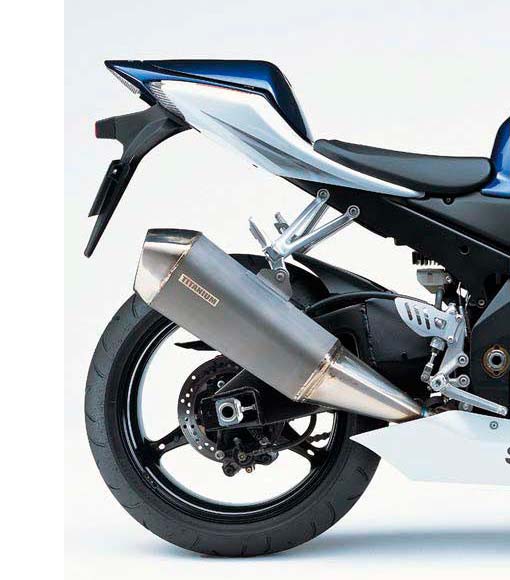
|
|
|
|
|
|
Classic Bikes
Custom Bikes
Individual
Racing Bikes AJP
AJS
Aprilia
Ariel
Avinton / Wakan
Bajaj
Benelli
Beta
Bimota
BMW
Brough Superior
BRP Cam-Am
BSA
Buell / EBR
Bultaco
Cagiva
Campagna
CCM
CF Moto
Combat Motors
Derbi
Deus
Ducati
Excelsior
GASGAS
Ghezzi Brian
Gilera
GIMA
Harley Davidson
Hero
Highland
Honda
Horex
Husaberg
Husqvarna
Hyosung
Indian
Jawa
Kawasaki
KTM
KYMCO
Laverda
Lazareth
Magni
Maico
Mash
Matchless
Mondial
Moto Guzzi
Moto Morini
MV Agusta
MZ / MuZ
NCR
Norton
NSU
Paton
Peugeot
Piaggio
Revival Cycles
Roland Sands
Royal Enfield
Sachs
Sherco
Sunbeam
Suzuki
SWM
SYM
Triumph
TVS
Ural
Velocette
Vespa
Victory
Vincent
VOR
Voxan
Vyrus
Walt Siegl
Walz
Wrenchmonkees
Wunderlich
XTR / Radical
Yamaha
Zero
Video
Technical
Complete Manufacturer List
|
Suzuki GSX-R 1000
For 2005, Suzuki set out to make its sports flagship smaller, lighter and more powerful than the previous K4 version. By shaving a millimeter here and a gram there overall weight has been reduced two kilograms to a svelte 166kg. The footpegs are lower and further forwards but lean angle isn't compromised because they've been moved inwards 17mm. The handlebars are slightly narrower, higher and further back, the back of the fuel tank is narrower (although it still holds 18 Litres ) and the seat height has been lowered by a significant 20mm to 810mm. The effect is to reduce seat-to-handlebar reach by 40mm without cramping the rider's legs, making the bike feel considerably more compact than its predecessor.
The liquid-cooled, four-cylinder engine has gained 11cc (to 999cc) and turns over an extra 1000 times a minute – thanks to titanium valves - to deliver a claimed 133kW at 11000rpm with 118Nm available at 9000 revs. It drives through a back torque-limiting "slipper" clutch and a six-speed gearbox. I can't tell you much about the clutch because I used it exactly once – pulling out of the pits lane – but the gearbox is well up to Suzuki's usual slick standards. It seemed very positive – if a little vocal – changing up at low revs as I felt my way round for the first few laps but as the revs built up its action became lighter and quicker. Full-throttle upshifts on the back straight were lightning-fast and almost imperceptible.
First gear is high –
possibly too high for comfortable road riding but perfect for getting off
the start line in a hurry - and the top five ratios are very close together;
you can actually use everything from second to sixth on a hot lap. Simply
closing the throttle and banging the lever down at the end of the straight
was an act of faith the first time but the action is light and the bike
never even twitched. All sports bikes should be like this – especially big
singles and twins with lots of engine braking.
On tiptoe
New Features Engine
Twin injectors per throttle body for improved throttle response
and acceleration - primary injector operates under all
conditions while secondary injector operates under high
rpm/heavy load conditions to further increase engine output New reinforced crankshaft and chrome-moly connecting rods, plus
recalibrated balancer shaft for dependable high rpm operation
New Chassis Bright 55/65W
headlight and reshaped taillight with new clear external lens

|
|
|
Any corrections or more information on these motorcycles will be kindly appreciated. |